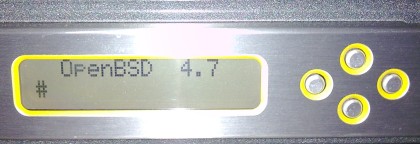OpenBSD sur Symantec 5420


L’appliance ne comportant pas de lecteur de CD, l’installation de l’OpenBSD se fait sur un micro de bureau en précisant le renvoi de la console sur le port COM1, puis le disque dur est installé dans le 5420.
Au démarrage la machine se bloque sur le message apm0 at bios0, il faut se connecter au port série et à l’invite boot> de l’OpenBSD, désactiver l’apm.
boot>boot -c ... ukc> disable apm ukc> quit
La machine doit démarrer, il faut alors fixer la modification dans le noyau :
# config -ef /bsd ukc> disable apm ukc> quit ... # reboot
dmesg :
OpenBSD 5.4 (GENERIC) #37: Tue Jul 30 12:05:01 MDT 2013
deraadt@i386.openbsd.org:/usr/src/sys/arch/i386/compile/GENERIC
cpu0: Intel(R) Celeron(R) CPU 2.00GHz ("GenuineIntel" 686-class) 2 GHz
cpu0: FPU,V86,DE,PSE,TSC,MSR,PAE,MCE,CX8,SEP,MTRR,PGE,MCA,CMOV,PAT,PSE36,CFLUSH,DS,ACPI,MMX,FXSR,SSE,SSE2,SS,HTT,TM,PBE,CNXT-ID,PERF
real mem = 796389376 (759MB)
avail mem = 771928064 (736MB)
mainbus0 at root
bios0 at mainbus0: AT/286+ BIOS, date 03/14/03, BIOS32 rev. 0 @ 0xf4a40
apm at bios0 function 0x15 not configured
pcibios0 at bios0: rev 2.1 @ 0xf0000/0x10000
pcibios0: PCI IRQ Routing Table rev 1.0 @ 0xf4eb0/256 (14 entries)
pcibios0: PCI Interrupt Router at 000:31:0 ("Intel 82801DB LPC" rev 0x00)
pcibios0: PCI bus #1 is the last bus
bios0: ROM list: 0xc0000/0xb000! 0xe0000/0x10000
cpu0 at mainbus0: (uniprocessor)
pci0 at mainbus0 bus 0: configuration mode 1 (bios)
pchb0 at pci0 dev 0 function 0 "Intel 82845G Host" rev 0x03
vga1 at pci0 dev 2 function 0 "Intel 82845G Video" rev 0x03
intagp0 at vga1
agp0 at intagp0: aperture at 0xc0000000, size 0x8000000
inteldrm0 at vga1
drm0 at inteldrm0
inteldrm0: applying pipe a force quirk
No connectors reported connected with modes
Cannot find any crtc or sizes - going 1024x768
inteldrm0: 1024x768
wsdisplay0 at vga1 mux 1: console (std, vt100 emulation)
wsdisplay0: screen 1-5 added (std, vt100 emulation)
uhci0 at pci0 dev 29 function 0 "Intel 82801DB USB" rev 0x02: irq 11
uhci1 at pci0 dev 29 function 1 "Intel 82801DB USB" rev 0x02: irq 10
uhci2 at pci0 dev 29 function 2 "Intel 82801DB USB" rev 0x02: irq 9
ehci0 at pci0 dev 29 function 7 "Intel 82801DB USB" rev 0x02: irq 5
usb0 at ehci0: USB revision 2.0
uhub0 at usb0 "Intel EHCI root hub" rev 2.00/1.00 addr 1
ppb0 at pci0 dev 30 function 0 "Intel 82801BA Hub-to-PCI" rev 0x82
pci1 at ppb0 bus 1
fxp0 at pci1 dev 0 function 0 "Intel 8255x" rev 0x10, i82551: irq 11, address 00:d0:68:02:37:68
inphy0 at fxp0 phy 1: i82555 10/100 PHY, rev. 4
fxp1 at pci1 dev 1 function 0 "Intel 8255x" rev 0x10, i82551: irq 7, address 00:d0:68:02:37:69
inphy1 at fxp1 phy 1: i82555 10/100 PHY, rev. 4
fxp2 at pci1 dev 2 function 0 "Intel 8255x" rev 0x10, i82551: irq 9, address 00:d0:68:02:37:6a
inphy2 at fxp2 phy 1: i82555 10/100 PHY, rev. 4
fxp3 at pci1 dev 3 function 0 "Intel 8255x" rev 0x10, i82551: irq 10, address 00:d0:68:02:37:6b
inphy3 at fxp3 phy 1: i82555 10/100 PHY, rev. 4
fxp4 at pci1 dev 4 function 0 "Intel 8255x" rev 0x10, i82551: irq 11, address 00:d0:68:02:37:6c
inphy4 at fxp4 phy 1: i82555 10/100 PHY, rev. 4
fxp5 at pci1 dev 5 function 0 "Intel 8255x" rev 0x10, i82551: irq 10, address 00:d0:68:02:37:6d
inphy5 at fxp5 phy 1: i82555 10/100 PHY, rev. 4
ubsec0 at pci1 dev 6 function 0 "Broadcom 5823" rev 0x01: 3DES MD5 SHA1 AES RNG PK, irq 9
ichpcib0 at pci0 dev 31 function 0 "Intel 82801DB LPC" rev 0x02: 24-bit timer at 3579545Hz
pciide0 at pci0 dev 31 function 1 "Intel 82801DB IDE" rev 0x02: DMA, channel 0 configured to compatibility, channel 1 configured to compatibility
wd0 at pciide0 channel 0 drive 0:
wd0: 16-sector PIO, LBA, 39205MB, 80293248 sectors
wd0(pciide0:0:0): using PIO mode 4, Ultra-DMA mode 5
wd1 at pciide0 channel 1 drive 0: < 8MB ATA Flash Disk>
wd1: 1-sector PIO, LBA, 7MB, 15680 sectors
wd1(pciide0:1:0): using PIO mode 4
ichiic0 at pci0 dev 31 function 3 "Intel 82801DB SMBus" rev 0x02: irq 7
iic0 at ichiic0
spdmem0 at iic0 addr 0x50: 256MB DDR SDRAM non-parity PC2700CL2.5
spdmem1 at iic0 addr 0x51: 512MB DDR SDRAM non-parity PC2300CL2.5
usb1 at uhci0: USB revision 1.0
uhub1 at usb1 "Intel UHCI root hub" rev 1.00/1.00 addr 1
usb2 at uhci1: USB revision 1.0
uhub2 at usb2 "Intel UHCI root hub" rev 1.00/1.00 addr 1
usb3 at uhci2: USB revision 1.0
uhub3 at usb3 "Intel UHCI root hub" rev 1.00/1.00 addr 1
isa0 at ichpcib0
isadma0 at isa0
com0 at isa0 port 0x3f8/8 irq 4: ns16550a, 16 byte fifo
com0: console
com1 at isa0 port 0x2f8/8 irq 3: ns16550a, 16 byte fifo
pckbc0 at isa0 port 0x60/5
pckbd0 at pckbc0 (kbd slot)
pckbc0: using irq 1 for kbd slot
wskbd0 at pckbd0: console keyboard, using wsdisplay0
pcppi0 at isa0 port 0x61
spkr0 at pcppi0
wbsio0 at isa0 port 0x2e/2: W83627HF rev 0x17
lm1 at wbsio0 port 0x290/8: W83627HF
npx0 at isa0 port 0xf0/16: reported by CPUID; using exception 16
mtrr: Pentium Pro MTRR support
vscsi0 at root
scsibus0 at vscsi0: 256 targets
softraid0 at root
scsibus1 at softraid0: 256 targets
root on wd0a (d33471c27c5d3981.a) swap on wd0b dump on wd0b
L’installation de lcdproc permet de gérer l’afficheur et les touches en façade.

Activation d’une carte vidéo PCI :
Connecter un clavier USB,
au démarrage de le machine, taper Delete plusieurs fois, pour rentrer dans le Bios Setup,
attendre une petite minute,
taper flèche vers le bas, une fois,
taper ENTREE
taper flèche vers le bas, cinq fois,
taper flèche vers la droite
taper F10
taper ENTREE
